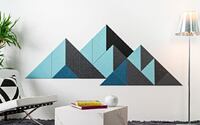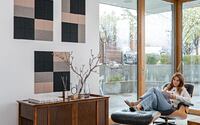The Science of Soundproofing Panels
Have you ever wondered about how sound operates? Why do things sound markedly different depending on the room they’re in? Much of the reason for the disparity for different sound environments is the room’s sound-absorbing ability.

Things like the Noise Reduction Coefficient determine how much vibrations and echo a material can reduce. But what makes soundproofing and sound damping panels work, and how can you choose which one fits your situation best.
This article uncovers how soundproof panels work and helps you understand their various applications and properties. Continue reading to learn all you need to know about soundproofing panels and whether you can use them to improve your home’s sound integrity.
Why Sound Control?
Controlling sound comes down to how much you want to comprehend and communicate in a given space. Your at-home office, for example, needs to have increased sound integrity so you can conduct meetings and remain productive. It’s hard to keep focused when there are always distractions bothering you.
Sound control solutions let you take the clutter out of your sound environment. Wherever you are, sound dampening and soundproofing measures allow you control your sound environment. You can implement these solutions anywhere. Sound dampening measures can modify any environment. From record studios to your car, sound dampening solutions help you maintain sonic control over your surroundings.
Rooms have sound thresholds. Once the room’s sound exceeds this threshold, conversations and communication can become nearly impossible, and “ear fatigue” can occur. Ear fatigue means you have to strain to comprehend conversations.
The competing sounds in a room become reflections because they bounce off the objects in the room in all sorts of directions, clouding the room’s sound integrity and confusing listeners. These reflections can be either the primary or first-order reflections that bounce off surfaces or the secondary reflections creating a reverberant field.
To control a room’s sonic ambiance typically requires mounting acoustic panels on the walls or hanging them on the ceiling. Adding these soundproofing panels to your room will quickly turn it into a comfortable space that facilitates communication.
What Are the Different Types of Echo You Need To Minimize?
Direct Sound
DIrect sound includes sounds issuing directly from a source- your voice, for example. Direct sound is typically the most important sound in a given environment. It is the sound people need to listen to; they don’t want to hear all of the other commotions.
Primary or First-Order Reflections
Primary or first-order reflections occur as echoes that bounce off nearby objects. They can interfere with the direct sound occurring within the room, and thus, they are very distracting. Controlling these sounds should be your priority when trying to hone a sound environment.
Flutter Echo or Room Chatter
If you clap your hands in an empty room, you’ll experience flutter echo and room chatter. These sounds are primarily reflective and they, allow echo to sustain itself. Flutter echo most often occurs from bouncing off walls. Because walls are most often responsible for flutter echoes, placing sound dampening panels can quickly reduce the flutter echoes within a room.
Secondary Reflections or Reverberation
The long trailing echo you hear in a church is reverberation. Some of your favorite music utilizes reverb to give the piece a far off, enchanting vibe. However, reverberation is only distracting when you’re trying to carry on conversations or get work done.
Absorbing Sound Vs. Blocking Sound
To understand how sound dampening wall tiles work, you must first understand the difference between absorbing and blocking sound. Many people mistakenly use these two terms interchangeably. However, there are a few key differences that result in different applications. Sound has similar properties to light in that white objects reflect light while black objects absorb light. Foam can either reflect sound or absorb sound. Absorbing sound reduces reverberations, while sound blocking foam prevents sound from entering a given space.
How Sound Dampening Foam Works
Sound dampening foam is a foam that absorbs sound, reducing the reverberation and echo within the room. They are typically more lightweight than soundproofing or sound-blocking foam. Their flexible, porous surface traps noises instead of deflecting them into the environment. Sound dampening foam achieves reduced reverberation by converting the sound waves into heat waves. It can also enhance the acoustics within a room. Pyramid and wedge shapes can manipulate sound vibrations to improve sound quality. Recording studios often supplement the environment by using sound dampening foam to reduce the echoes within the room.
What Is the Difference Between Sound Dampening Panels and Soundproofing Panels?
The difference between sound dampening panels and soundproofing panels is that sound dampening panels aim to reduce the errant vibrations occurring within a room. Soundproofing panels aim to block any sound from entering the room. Sound-proofing panels are more dense materials that deflect sound waves back into the environment from whence they came. Most settings don’t require the use and implementation of soundproofing materials. Recording studios are the only environments that require such extensive sound modulation. They need that level of soundproofing because you can’t afford to compromise any sound quality when recording. Any unwanted sound can ruin the recording process.
Conclusion- The Science of Soundproofing Panels
Soundproofing panels can improve the sound integrity of any environment they inhabit. However, most environments only require sound-damping panels- they don’t need that level of sound treatment. One of the best materials for sound dampening is sound damping felt. These felt acoustic panels are easily installed in any room and don’t require invasive removal techniques that damage your walls or ceilings. They are also highly customizable and they have dual purposes as art in your spaces.
- by Matt Watts



